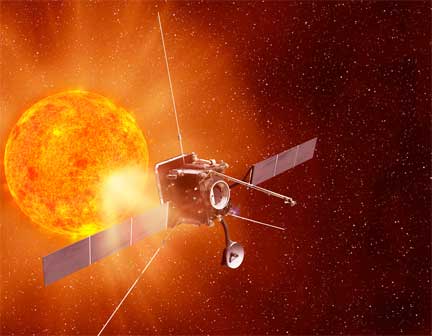
Artistic rendition of the ESA's Solar Orbiter.
Image courtesy of Astrium.
...Solar Orbiter mission that will perform close-up observations of the Sun. With this 300 million euros contract signed in London, Astrium builds upon its extensive science mission expertise that includes the solar spacecraft SOHO and Ulysses. Solar Orbiter is the first mission in ESA’s Cosmic Vision program to start its implementation phase and is scheduled for launch in 2017. The mission lifetime will be seven years.
Solar Orbiter will study the Sun in detail and its effects on the solar system. The spacecraft will carry a suite of complementary instruments that will measure the particles, fields and waves of the plasma through which it travels, and at the same time make observations of the Sun’s surface and outer atmosphere, the photosphere and corona. At its closest point Solar Orbiter will be closer to the Sun than the planet Mercury, at a distance of 0.28 Astronomical Units (42 million kilometers), in an orbit that takes it out of the ecliptic plane. From here, it can perform long-duration observations of the same region of the Sun’s surface, and have visibility of the Sun’s polar regions. It will be one of the closest approaches of the Sun by any spacecraft. To position itself in this challenging orbit, Solar Orbiter will make a complex series of gravitational-assist fly-bys past both Earth and Venus.
Design challenges include accommodating and resourcing a large suite of cutting-edge instruments and ensuring stringent magnetic and molecular cleanliness to enable the most sensitive scientific measurements to be made effectively. At its closest approach, where sunlight is thirteen times more intense than it is for satellites orbiting the Earth, Solar Orbiter must survive intense thermal radiation and protect its instrument suite, while at the same time allowing those instruments to observe the Sun. To achieve this, the design includes a heat shield and incorporates new high-temperature solar array technology.
Solar Orbiter builds on hugely successful missions such as SOHO and Ulysses that have provided remarkable insights into the workings of our Sun. Like those missions, it is a collaboration between ESA and NASA—a launcher will be provided by NASA and one instrument and one sensor will be contributed from the United States. SOHO was developed by Astrium for the European Space Agency and launched in December 1995. From its orbit 1.5 million km from Earth, it has been observing the Sun for 17 years with 12 different instruments, revealing new information on the Sun’s interior, surface, the solar wind and its interaction with the interstellar medium. It has also revolutionised space weather forecasting and can provide up to three days notice of major solar events that impact our planet. Astrium was also the prime contractor of ESA’s Ulysses mission. Ulysses operated for 18.5 years in an orbit taking it far above the Sun’s poles. Key discoveries include measurements of the solar wind from the Sun’s polar regions, the discovery that the magnetic flux from the Sun is uniform at all latitudes and the discovery of interstellar dust in the solar system.

